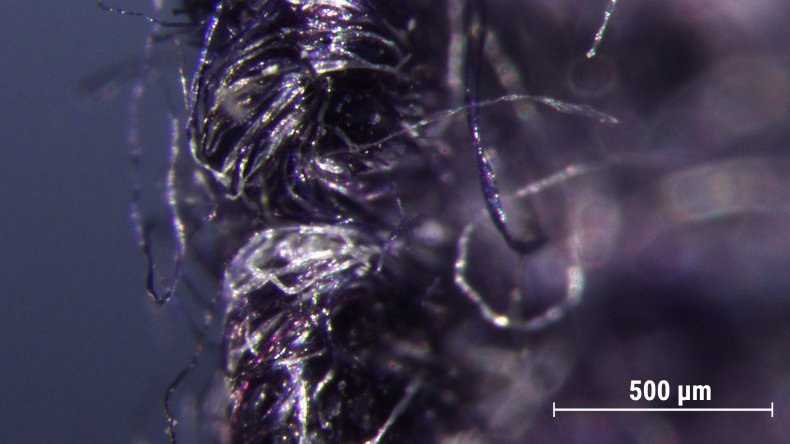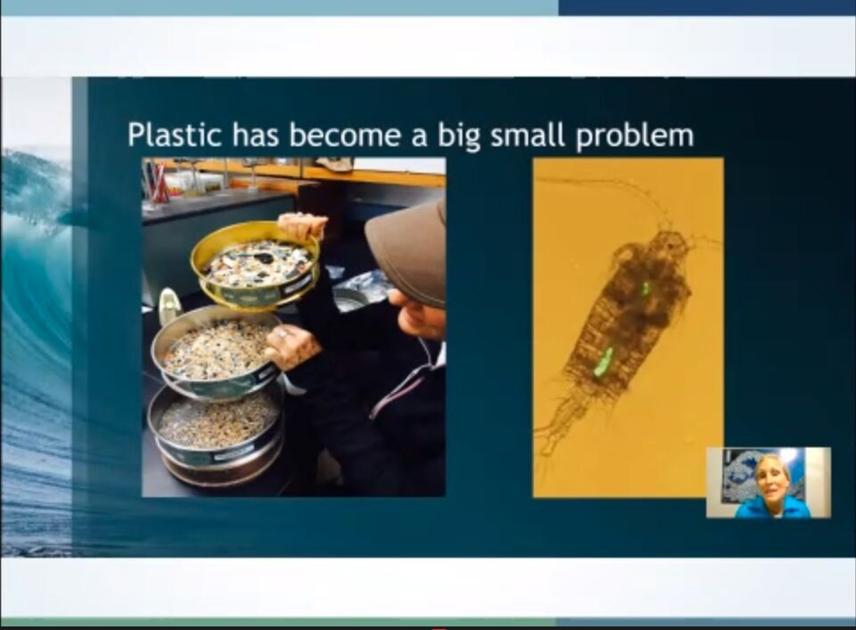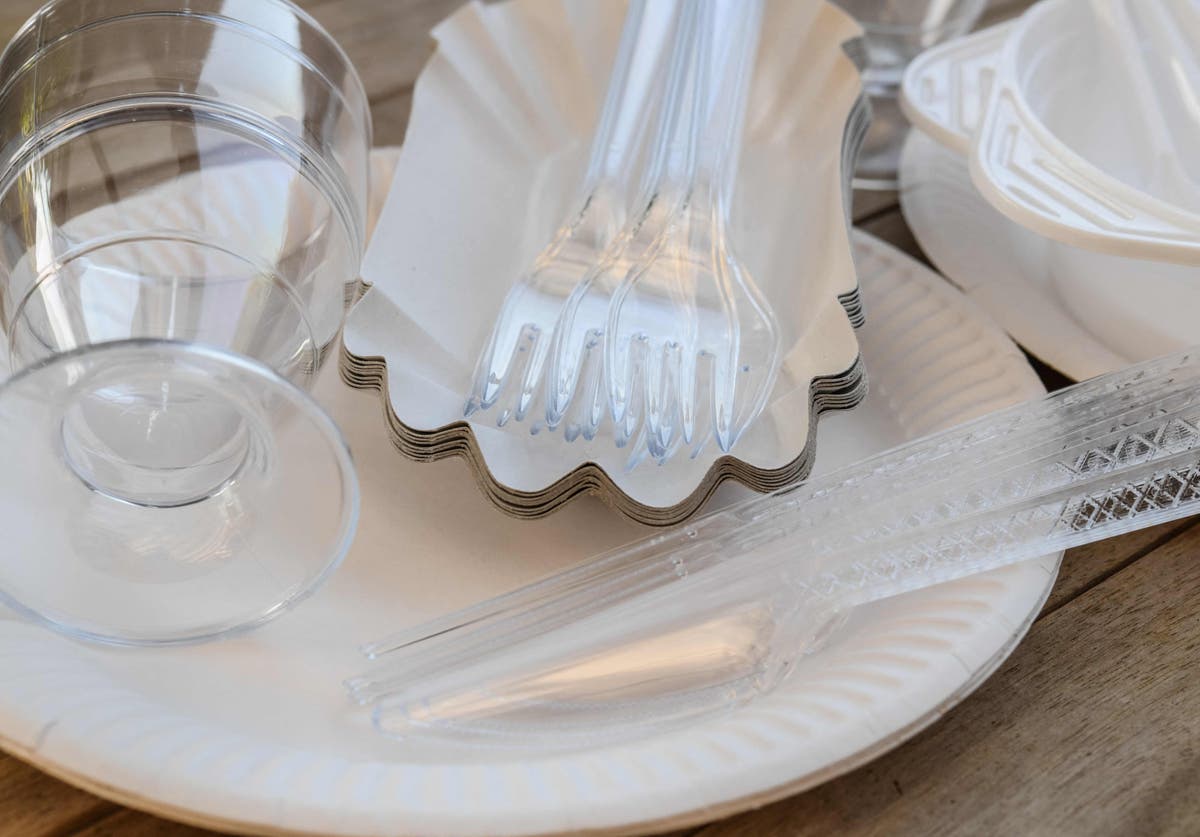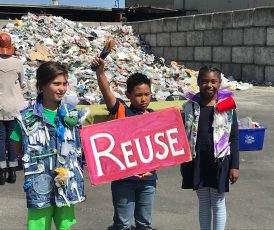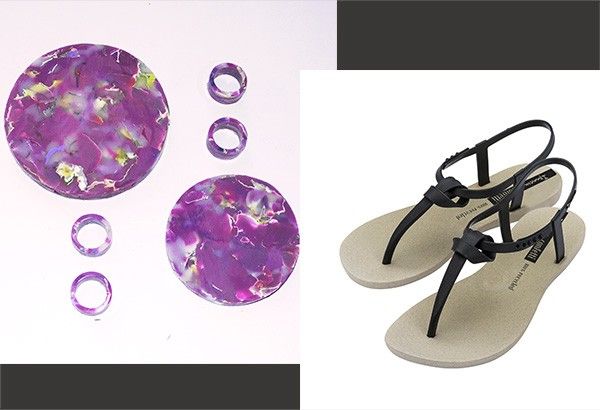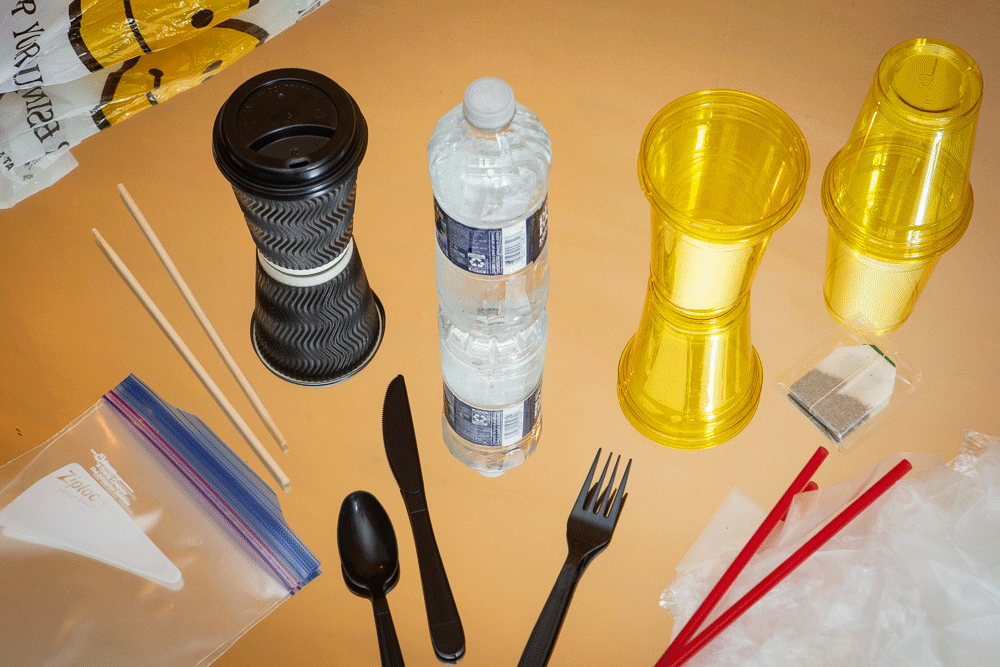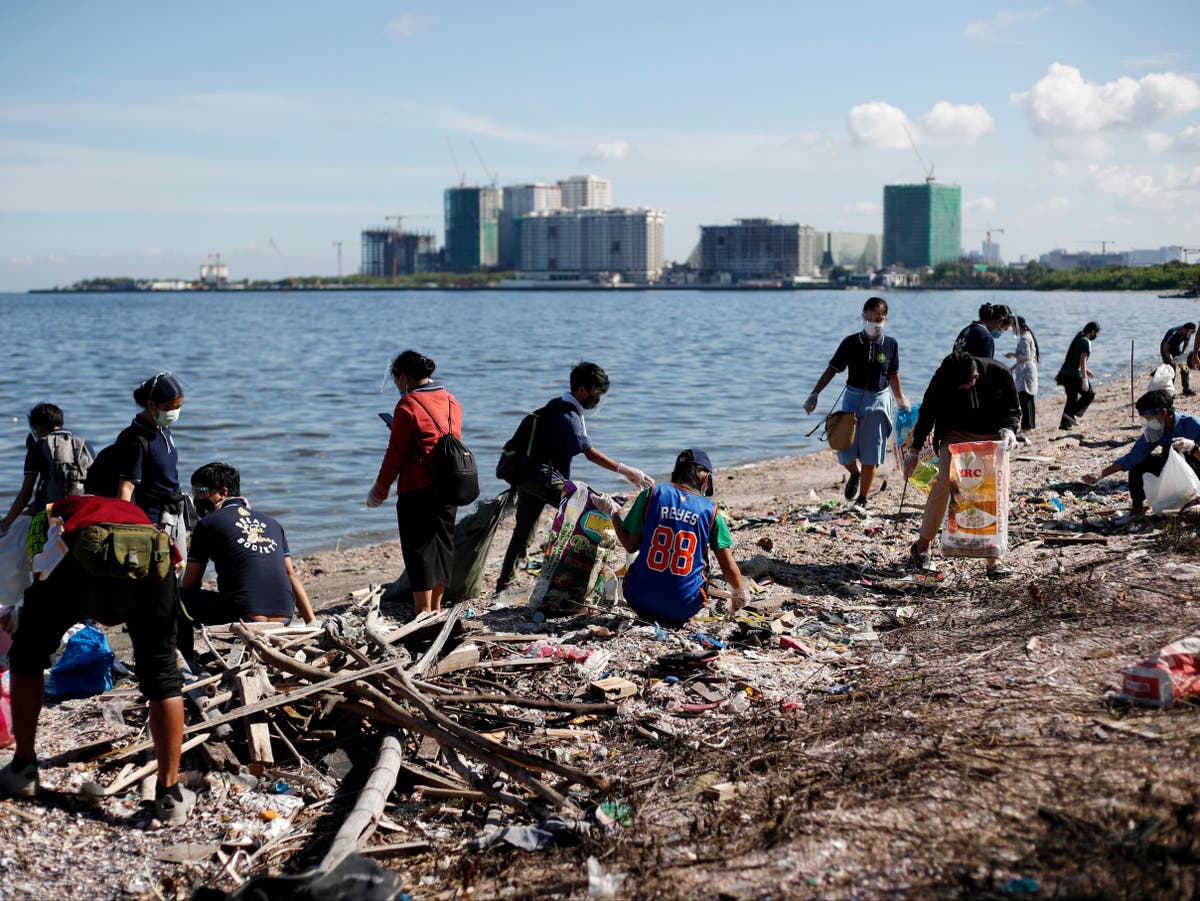Every time we wash our synthetics, little bits of plastic leach out of our clothes, swirl down the drain, and make their way into the ocean.Those tiny shreds are called microfibres, a type of microplastic formed after larger materials have broken down. At five millimetres or smaller, they’re a growing problem in the world’s waters. They harm the food chain, showing up in plankton, the digestion systems of mammals, and seafood consumed by humans.A report by the International Union for Conservation of Nature found 35 per cent of primary microplastic pollution comes from synthetic clothing and textiles, with the remaining from cigarette butts, personal care products and other plastic products. In the Arctic of Eastern Canada, researchers found they were present in almost all water samples.Get top stories in your inbox.Our award-winning journalists bring you the news that impacts you, Canada, and the world. Don’t miss out.It’s part of the larger picture of Canada’s plastic problem, which sees 3.3 million tonnes of plastic thrown away each year, with only nine per cent making it to the recycling bin. However, a new study from Ocean Wise offers a hopeful perspective, says Laura Hardman, director of its Plastic Free Oceans campaign. The report, released this month, found microplastic can be significantly reduced by upgrading filters in washing machines. The new filters have the potential to catch up to 90 per cent of microfibres.Microfibres under a microscope. Image courtesy of Ocean WiseResearchers tested two types of lint traps, by LINTLUVR and Filtrol, which Hardman said most washing machine brands could incorporate into their existing systems to cut down on plastic waste. Clothing corporations could also use more-efficient filters and do a pre-wash before sending goods to consumers, the report suggests, since most fabrics shed the majority of their microfibres during the first wash. Also, an option is to have businesses vacuum away the particles during production. What people are reading Washing machine filters aren’t the be-all and end-all to solving microfibre pollution, but Hardman says they could be an effective and immediately available intervention. The filters can be used with any machine, although depending on the size of your machine hose, a pliable hose and clamp might be needed to fit the filter to the machine.“On average, 533 million microfibres are being released by your average Canadian and U.S. households and discharged into the environment. And that adds up to 85 quadrillion microfibres, believe it or not, into the wastewater annually in Canada in the U.S.,” she explained, referencing an earlier Ocean Wise study.“To visualize it, that’s the equivalent of 10 blue whales of microfibres entering our oceans, rivers and lakes every year.”Microplastics have been found in our food and water, although the impacts are not yet known. Graphic courtesy of Ocean Wise An @OceanWise report found microplastics can be significantly reduced by upgrading filters in washing machines. The new filters have the potential to catch up to 90 per cent of microfibres. #PlasticPollution The study of microplastics is still relatively new, says Hardman, who explains that further research needs to be done to explain what percentage of microfibres are released once garments are brought home versus during the production process, as well as the breadth of the effects on humans and animals.A 2019 University of Victoria study looked into the latter, and it found that people are consuming tens of thousands of plastic particles per year. Again, researchers say the full impacts need to be further analyzed, but that it’s an important step in understanding plastic pollution.Not only can microplastics be ingested, but they exist in the air and can be breathed in, explains lead author Kieran Cox.“Human reliance on plastic packaging and food-processing methods for major food groups, such as meats, fruits and veggies, is a growing problem. Our research suggests microplastics will continue to be found in the majority — if not all — of items intended for human consumption,” said Cox. “We need to reassess our reliance on synthetic materials and alter how we manage them to change our relationship with plastics.”So do corporations, says Hardman, who says clothing businesses can do things like design fleece (a main microfibre culprit) to have lower shed rates and create long-lasting garments.The report is part of the organization’s ongoing microfibre project, which sees collaborations between players in the clothing industry as well as government to work towards microplastic solutions, so she’s hopeful that more businesses will start to adopt suggested practices. Individuals can purchase long-lasting garments or secondhand items, rather than fast-fashion goods, which are more likely to shed microfibres. “It really energizes us to keep asking the challenging questions that are going to empower and enable businesses to take action and individuals to take action. We all have a part to play … it’s not just business, it’s not just policymakers, it’s not just consumers,” she said.“We are all part of the system. And we all have a role to play in tackling this very real problem, which is only going to grow if we don’t take action now.”
Category Archives: Plastic Pollution Articles & News
Why chemical pollution is turning into a third great planetary crisis
Thousands of synthetic substances have leaked into ecosystems everywhere, and we are only just beginning to realise the devastating consequences
Earth
21 July 2021
By Graham Lawton
Marcin Wolski
IT IS the 29th century and Earth is a dump. Humans fled centuries ago after rendering it uninhabitable through insatiable consumption. All that remains is detritus: waste mountains as far as the eye can see.
This is fiction – the setting for the 2008 Disney Pixar movie WALL-E. But it may come close to reality if we don’t clean up our act. “We all know the challenge that we’ve got,” says Mary Ryan at Imperial College London. “We can find toxic metals in the Himalayan peaks, plastic fibres in the deepest reaches of the ocean. Air pollution is killing more people than the current pandemic. The scale of this is enormous.”
Back when WALL-E was made, pollution and waste were near the top of the environmental agenda. At the 2002 Earth Summit in South Africa, global leaders agreed to minimise the environmental and health effects of chemical pollution, perhaps the most insidious and problematic category. They set a deadline of 2020 (spoiler alert: we missed it).
Recently, climate change and biodiversity loss have dominated environmental concerns, but earlier this year the UN quietly ushered pollution back to the top table. It issued a major report, Making Peace with Nature, declaring it a third great planetary emergency. “Do I think that is commensurate with the risk? Yes, I do,” says Ryan.
“It justifies being right up there at the top,” says Guy Woodward, also at Imperial. The key question, though, is what pollutants we should be worried about. “Many are innocuous. Some aren’t. Some interact in dangerous ways. That is what we need to grapple with,” says Woodward.
Pollution, the …
NC Coastal Federation, partners talk combatting microplastic pollution
NEWPORT — Plastic pollution is a widespread problem throughout the world’s oceans and waterways, and environmentalists encourage people, businesses and governments to all take action.The N.C. Coastal Federation, a Carteret County-based nonprofit dedicated to protecting the state’s coastal environment, hosted an online forum Thursday on microplastic pollution, and more than 300 attendees registered worldwide.Microplastic is plastic that has broken down into pieces no bigger than 5 milimeters. Studies have found it polluting vast amounts of the oceans and inland water bodies, resulting in people and wildlife ingesting it, which can be hazardous to health.
NCCF Executive Director Todd Miller said a big part of the solution is raising public awareness of microplastic pollution.“We’re still in the early stages of exposing this issue to the public,” he said. “We’re at the state where we know the issue is spreading.”Mr. Miller also said microplastic pollution is tied to a lot of coastal issues the federation has been dealing with.“Storm debris is a major issue,” he said. “As we’ve talked about coastal resiliency…in North Carolina, microplastics are just starting to come into the conversation. The important thing is going to be identifying where opportunities are to do something.”NCCF assistant director of policy Ana Zivanovic-Nenadovic said microplastics have “permeated our lives” since the 1960s, when mass production of plastic products took off.“It’s in the water, the air and the wildlife,” she said. “It’s a problem.”Plastic Ocean Project Executive Director Bonnie Monteleone was one of several speakers who joined the forum. Ms. Monteleone said scientific study shows 11 million metric tons of microplastics go into the oceans annually from runoff alone, affecting 638 marine species.“The plastics in the oceans aren’t creating an island,” she said, “it’s more creating a soup.”Ms. Monteleno said plastics will break up into smaller and smaller pieces, but they never “break down,” that is they never lose the properties that make them plastics. Studies show microscopic plastics are being eaten by microorganisms, which are in turn eaten by larger and larger predators, causing these plastics to build up in their bodies.“We used to intentionally dump plastic into the ocean,” Ms. Monteleno said. “An international law went into effect (in 1988). It took a good 20 years for a law to be made.”One considerable source of microplastics are microfibers, tiny pieces of fiber that can be coated with plastic. N.C. State University graduate student Dr. Marielis Zambrano said microfibers can find their way into the water and the air through laundering synthetic fabrics, like polyester.
“You have microfibers coming off (synthetic fabrics) throughout the life cycle of a product,” NCSU Elis-Signe Olsson Professor of Pulp and Paper Science and Engineering Dr. Richard Venditti said.Potential solutions include filters for washing machines and dryers, adding a finish to fabrics and replacing synthetic fabrics with natural, plant-based or biodegradable ones.While all the effects of microplastics on human and animal health aren’t known, scientists have determined they are hazardous. California State Water Resources Control Board research scientist Dr. Scott Coffin said plastic additives can disrupt endocrines in humans.He said a 2017 study showed 83% of worldwide tap water sources had microplastics in them.“Currently there are no standardized methods to monitor (water sources) for microplastics,” he said.As of Wednesday, a monitoring method is under development in California.Water isn’t the only source of microplastics that get into people’s bodies.“We find that air is likely our greatest exposure pathway,” Dr. Coffin said. “We find much of this (exposure) is indoors. We know microplastics don’t go away after you ingest them.”Regulatory action is one part of the response to the issue of microplastics. Wake Forest University School of Law associate professor Sarah Morath said two things to consider when creating regulations to reduce microplastic pollution is what part of the lifecycle of plastics should be regulated and who should be responsible for doing the regulating.“I think we’ve learned plastic is ubiquitous,” Ms. Morath said. “You can’t underestimate the importance of letting your elected representatives known you’re concerned about the issue.” Mr. Miller agreed with Ms. Morath.“I think people have to recognize this is an issue,” he said. “I think we’re on our way. I think we need to look at opportunities in North Carolinian to create role models through legislative action…We need to support the science.” Contact Mike Shutak at 252-723-7353, email mike@thenewstimes.com; or follow on Twitter at @mikesccnt.
Failure to introduce single-use plastics ban is ‘dereliction of Brexit promise’
The government has failed to uphold its promise of ensuring the UK’s environmental standards do not drop following its departure from the European Union, campaigners say.EU member states are currently legislating to ban most single-use plastics, including cutlery, plates and polystyrene food containers.But despite regularly stating that the country would uphold high post-Brexit environmental standards, UK ministers have yet to legislate to ban these polluting plastics.More than 20 environmental groups, including Greenpeace, Friends of the Earth, City to Sea and Keep Britain Tidy are due to challenge the government on its commitments, according to PA news agency.In a letter on Tuesday to environment minister Rebecca Pow, they will warn that a failure to keep up with EU anti-plastic regulations would be an “awful dereliction of promises to lead on environmental issues post-Brexit”.Single-use plastic straws, stirrers and cotton buds have been legislated against but plastic cutlery, plates, sticks attached to balloons as well as tough-to-breakdown plastic food containers and packaging are still allowed in England.The letter accuses the government of “not only failing to take the lead on tackling plastics but is falling behind our European neighbours and devolved nations within the UK” if it does not ban the polluting items listed in Article 5 of the EU single-use directive, which came into force on 3 July.The coronavirus pandemic has led to fresh fears over the increase of single-use plastics ending up on Britain’s beaches and waterways, following the sharp rise in demand for disposable face coverings and other personal protective equipment (PPE).Steve Hynd, policy manager at the not-for-profit plastic pollution campaign group City to Sea said: “It’s frankly embarrassing that while other governments are pushing ahead ours is still lagging behind.“If the Government fails to meet these minimum standards it would be an awful dereliction of their promises to lead on environmental issues post Brexit.”Nina Schrank, senior campaigner at Greenpeace, said: “The Government claims to be a leader in tackling plastic pollution, yet is falling behind in the most basic of measures.“They need to match EU legislation in banning some of the most harmful single-use plastics, at the very least.”A spokesperson for the Department for Environment, Food and Rural Affairs said: “The UK is a global leader in tackling plastic pollution.“We have banned both microbeads in rinse-off personal care products and the supply of plastic straws, stirrers and cotton buds, and our carrier bag charge has cut sales by 95% in the main supermarkets.“Our landmark Environment Bill will give ministers the power to introduce deposit return schemes for plastic drinks containers and make companies more responsible for the packaging they produce, who will be incentivised to use more recyclable materials and to meet higher recycling targets.“The Bill will also make it easier for ministers to place charges on single-use plastic items that threaten our ecosystems, and we are currently exploring options for which items to target next.”Additional reporting by PA
Covid has made us use even more plastic – but we can reset
OpinionPlasticsCovid has made us use even more plastic – but we can resetChristian DunnLockdown has highlighted the versatility of this everyday material, while creating a mountain of waste Mon 19 Jul 2021 04.00 EDTLast modified on Tue 20 Jul 2021 04.51 EDTEvery time you do a lateral flow coronavirus test, you throw away around 10g of plastic. If every adult and secondary school student in the UK did the recommended two tests a week, it would produce more than 1,000 tonnes of rubbish every seven days. In less than a month this would fill an Olympic-size swimming pool.Those of us who before the pandemic were involved in campaigns to cut our dependence on plastic, encouraging our communities to become “plastic free”, may feel like criticising such consumption. Should we stop these tests, knowing what we do about the plastic pollution crisis?Absolutely not. They are at the forefront of our ability to control the virus and help our country return to a form of normality. So too are the countless tonnes of plastic used in the development, production, transportation and delivery of the vaccine, not to mention all the single-use medical consumables essential to help those unfortunate enough to end up in hospital.Plastic has shown yet again what a wonderful, versatile and lifesaving product it can be. Without it, the pandemic would be going very differently. However, it is all too easy to forget this when stepping over the Covid cast-offs littering our streets. Single-use face masks, surgical gloves, tiny bottles of hand sanitiser and antiseptic wipes have become as common as cigarettes butts were a few years ago.An interesting aspect of all this is a recently identified phenomenon called “hygiene theatre”. That is, individuals and businesses that make sure they look like they’re fighting the pandemic, but perhaps not doing very much of real effect. From repeatedly incorrectly changing single-use face masks to the use of disposable laminated menus in restaurants and metre-high plastic dividers between tables in rowdy pubs, there has arguably been an abundance of this behaviour throughout the various stages of the pandemic. And as we now approach the great unlocking on 19 July, some measures and behavioural changes are likely to remain – not least our desire to be personally protected, and our increased dependence on takeaway food and online shopping, both great generators of plastic. But the question is, how can we achieve safety and convenience in our post-lockdown world in a more balanced way?The most visible symbol of the pandemic also presents us with an excellent case study for how necessary this rethinking is: face masks. A single-use disposable face mask can be 10 times more damaging to the climate than a reusable cotton one. Most of us, most of the time, when we’re nipping into shops do not need to use a disposable surgical-type face mask. Yet still 53m are being sent to landfill every day in the UK, which doesn’t cover all those that make up the bulk of Covid cast-offs on our streets.A significant proportion of people are using them because of our accepted cultural insistence on convenience, or perceived convenience. We think it’s easier to pick up a throwaway mask when we’re entering a shop than it is to remember our own, in the way it was once more convenient to use free plastic bags in a supermarket than remember our own. But shifting our reliance away from single-use plastic doesn’t have to mean the end of convenience – far from it. Instead it just means we need to move towards “considerate convenience”: giving a little more consideration to our actions, and being a bit more considerate towards each other and the planet.There have been reports of takeaway sales surging by up to 600% during lockdown. This, in turn, brings a mountain of single-use plastic to landfill. A great example of considerate convenience in this sector is the Shrewsbury Cup scheme, whereby the town’s cafes all using the same type of reusable take-out cup. Customers pay a deposit for the cup which can be returned to any of the businesses serving drinks. It’s then washed and reused. Yes, it may require a tiny bit more effort than just throwing a used cup in the bin, but it’s far better for the environment. The Shrewsbury Cup scheme is part of a wider move among increasingly environmentally conscious takeaway providers to find plastic-free ways of delivering food, including, for example, making deliveries in sturdy packaging customers can take away with them again.Little known too is that Amazon will reduce the plastic packaging used in your deliveries – but you have to contact customer services to ask for the option to be applied to your account. Hope is also provided by a growing amount of biodegradable plastic coming on to the market.The UK won’t meet its ambitious climate goals by making spending cuts | Larry ElliottRead moreImproving plastic recycling is another area that needs investment to ensure it’s both efficient and viable. Less than 10% of plastic is currently recycled and this is usually downgraded to poorer quality plastic. Alternatives to plastic need to be considered wherever possible. Moves are being made to make the polluter pay, which could see companies such as Coca Cola take responsibility for the plastic rubbish they produce. It’s also clear that the traditional take-make-waste model for our plastic use must be replaced with a more circular system – designing products and consumer processes differently.The pandemic has highlighted the good and the bad of plastic use, showing more clearly than ever that plastic consumption is all about balance. Wasteful use of virgin plastic turns our oceans into plastic soups. This was part of the message many of us were trying to get out before the pandemic hit. Now that we’re being urged to “build back better” as we come out of lockdown, let’s seize the opportunity to change our thinking about plastic. Let’s appreciate what a wonderful resource it can be – and crucially let’s realise that, like all resources, it must be used wisely and not wasted.
Dr Christian Dunn is a senior lecturer in zoology at Bangor University and an environmental campaigner
TopicsPlasticsOpinionCoronavirusFood & drink industrycommentReuse this content
LISTEN: Terra Verde: Let's get plastics out of schools
Jacqueline Omania’s Zero Waste classroom in Berkeley has managed to generate only a jar of waste during the entire school year. Photo by Jacqueline OmaniaEarth Island Journal editor and Terra Verde host Maureen Nandini Mitra talks about plastic waste and classroom solutions with Jacqueline Omania, the inspirational educator behind Berkeley’s Oxford Elementary School’s Zero Waste Classroom Project and winner of the 2019 Presidential Innovation Award for Environmental Educators, and Dianna Cohen, founder and CEO of Plastic Pollution Coalition, a global alliance of individuals, organizations, businesses, and policymakers working toward a world free of plastic.
Make profit, not pollution: How businesses turn trash into cash
MANILA, Philippines — Did you know that a single plastic bottle could take up to 450 years to fully decompose?
A lifetime of indiscriminate disposal of plastics can be detrimental to the ocean, marine life and landfills that could leak toxic pollutants to food and water systems.
Sustainable living might be costly, for now, but it pays to pay it forward. There are ways to mitigate the irreversible effects of plastic pollution, and several organizations have partnered to make it easier for the public to contribute to proper plastic disposal.
From waste to life-savers
Beauty brand Garnier, retail chain Watsons and The Plastic Flamingo launched its first ever Plastics Collection Program. The program accepts plastic donations that will be turned into eco-planks and will be used to build emergency shelters for the less fortunate.
The Plastic Flamingo is a social company based in Manila that collect and recycles plastic waste.
“We are one in pursuing our shared vision of responsible stewardship of our planet and clean beauty accessible to all. It starts with us, and it takes a global brand like Garnier and a retail giant like Watsons to get things started and take the leap towards sustainability. By partnering with The Plastic Flamingo, we are able to leverage their expertise on innovative and relevant ways of reusing plastics – like building infrastructure for emergency shelters. There’s a lot more to be done and the sustainability journey is far from over, but with these steps, we are paving the way to a brighter future” said Josteen Vega, Garnier Marketing Manager.
The brand partnered with e-commerce site Shopee with the Green Parcel partnership. The beauty brand also got its global accreditation from Cruelty Free International under the Leaping Bunny Program. The program is a globally-recognized standard for cruelty-free products in terms of cosmetics, personal care and household care.
Step into 100% recycled sole mates
Ipanema and Rider, two of the most sought-after Brazilian casual footwear brands, recently launch new products that allow you to revel in the experience of wearing everyday-appropriate footwear.
Nowadays, flip-flops and slip-ons have become the most convenient footwear choice: comfortable enough for essential outdoor runs and stylish enough for most outfits, not only are these pairs the easiest kind of footwear to disinfect, but they are also just as good to wear while staying at home.
This month, the duo releases respective collections that help the environment and allow you to be your most authentic self. Aptly named Confetti, Ipanema is overjoyed to release its first pair of flipflops 100% made of recycled materials. The Brazilian brand has always been at the forefront of promoting sustainable manufacturing in the fashion industry, creating footwear with no components of animal origin, 100% recyclable, and contains up to 30% pre-consumer recyclable materials for years—but it’s the first time they have been able to develop a product that is not only 100% recyclable, but made of 100% recyclable materials as well.
The Confetti is a thong-style flat sandal with a rounded toe, textured sole and adjustable ankle straps. A pair that comes in a gorgeous sand color with contrasting black straps, it proudly bears the brand’s signature at the bottom, with a mark that says “100% recycled.”
The company believes that fashion brands have the ability to create beautiful, wearable and durable products that are produced ethically, with a reduced impact on the environment and a lasting contribution to the welfare of their employees and the communities within which they belong.
Now available in the brand’s stores as well as online and in Bambu, The SM Store, Sports Central and Robinsons Department Stores, Confetti is just the beginning of a groundbreaking movement within the brand to create more 100% recycled and recyclable footwear jn the years to come.
‘May pera sa basura’: The circular economy of plastics
The phrase “May pera sa basura” has long been heard in the Philippines. Newspaper drives and glass bottle collection initiatives are common measures to recycle. The same process can apply to plastic packaging. The concept of the “circular economy of plastics” means that plastic is viewed as a material that can be reused, to avoid depleting natural resources. This is a concept and economic model that Mondelez Philippines supports, in line with its goals towards zero waste to nature by 2030.
According to the Ellen MacArthur Foundation, the “circular economy of plastics” means “A system in which materials are designed to be used, not used up.” The foundation works at promoting and developing this economic model. Think about it, our economy today continuously churns packaging material using irreplaceable natural resources like fuel, with the intent of making them single use. But they don’t have to be used just once. Plastic packaging can and should be recycled to avoid them becoming waste or polluting marine life. In fact, using plastic as a resource that can be recycled continuously is giving rise to industries that make a profit while preventing waste.
One such organization is Plastics by Manila Automat, a collaborative design and production studio aimed at renewing the value of recycled plastic waste by encouraging people to become modern-day recyclers. The group collects plastic waste – from bottles to sachets, and turns them into practical, usable, and creative materials for consumers to purchase. Theirs is a business that literally runs on waste.
“We started our Company based on a belief that plastic should be reused and is a valuable material,” shared Mica Agregado, Head of Designs. “Since 2019 we have sold 436 pieces of our home and fashion pieces and in the process, recycled 327 kg of plastic packaging.”
Another organization that uses waste as a resource is Green Antz Builders, an innovative product and technology development company that creates Eco-bricks and construction materials made with recycled plastic. A pioneer in the Philippines on circular economy, Green Antz has carved a niche as a green construction materials company but at the same time, are strong advocates on the use of green materials and technologies.
The company builds and runs Green Antz Eco-Hubs which are like modern Materials Recovery Facilities (MRFs) in communities. These Eco-Hubs function as plastic collection points, recycling facilities, and manufacturing hubs with a socially-inclusive model. Green Antz collaborates with surrounding communities and partner organizations in collecting plastic and running educational workshops or seminars in the communities on proper waste segregation at source. The Eco-Bricks, Eco-Casts, and Eco-Pavers produced in these facilities, coming from the plastic waste collected, are tangible outputs that the circular economy works and creates shared value across its stakeholders.
“Our Eco Products not only divert tons of plastic waste away from oceans and landfills, and repurposing them into green materials used in the construction industry, they are also uniquely designed and engineered stronger than regular hollow blocks and use less water to build into structures,” shared Rommel Benig, Founder and CEO.
“Green Antz has created a trailblazing platform for Environmental, Social, Governance (ESG) initiatives. We have built our entire business on the idea that plastic waste is a resource as valuable as paper or glass, and can be reused.” In 2020 alone, Green Antz collected and diverted close to 100,000 kgs of plastics away from landfills or oceans.
Plastics by Manila Automat and Green Antz are two of the organizations snacks company Mondelez Philippines is working with to help promote and strengthen the plastics recycling industry in the Philippines. As a member of the Ellen MacArthur Foundation’s New Plastics Economy Global Commitment, the Company globally supports the New Plastics Economy Initiative.
“We want to contribute to a circular economy where packaging material is recycled or reused, while minimizing food waste and the overall environmental impact of packaging, including on climate change,” explains Atty. Joseph Fabul, Country Manager for Corporate and Government Affairs of Mondelez Philippines. “To help achieve this, we are working to find solutions to the shared problem of packaging waste – fixing broken processes, policies and perception. These include making all our packaging recycle-ready and labelled with recycling information for consumers by 2025. We also committed to invest in waste management projects where we are present and ensure that by 2025, 5% of our plastic packaging is from recycled content.” “The next time you hear the phrase “May pera sa basura,” think of the circular economy of plastics and how recycling can indeed change a problem into an opportunity,” ended Atty. Fabul.
Offseting plastic footprints by going cashless
Plastic Credit Exchange (PCX), the first global non-profit plastic offset program, recently partnered with Microsoft to develop a blockchain-protected credit registry. The revamped credit registry will ensure the public and relevant stakeholders that all transactions within the Exchange are secure, transparent and reliable.
Established in 2019, PCX partners with sustainably conscious businesses worldwide to responsibly offset their plastic footprints. PCX has built a wide ecosystem of partners to facilitate the recovery, transport, and processing of post-consumer plastic waste, seeking out the most environmentally sound solutions. Company pledges undergo verification via a third-party audit and are made transparent through the PCX public registry.
Founder and Chairwoman Nanette Medved-Po shared, “It is important that the credit registry is trustworthy and available to the public. By using blockchain technology to not only protect the ledger, but provide transparency around additionality and protect against double counting, stakeholders will know where and how they positively impact the environment.”
Blockchain technology has the potential to extend digital transformation beyond any organization’s boundaries and into the processes it shares with suppliers, customers and partners. At its core it is a shared, distributed, secured, immutable ledger which is connected in a peer-to-peer network.
PCX sought Microsoft as a global technology partner for a Microsoft Azure-based blockchain solution. Microsoft prototyped a blockchain-protected ledger through its Microsoft Technology Center (MTC) to provide confidence, traceability and transparency within the PCX ecosystem.
To lay the foundation for the solution, MTC configured PCX’s existing credit registry and infrastructure with Quorum Blockchain deployment on Azure by setting up permissions and providing identified user access to ledger through secure API. Improving upon PCX’s existing workflow, MTC iterated blockchain-based solution scenarios. This prototype incorporates PCX’s current processes via web application enabling the blockchain to integrate into their operations. Because the app is API-enabled, PCX can seamlessly extend their credit registry to more partners in the future.
“Our decision to partner with Microsoft went beyond finding a technology partner. We found a business partner whose sustainability goals aligned with ours and whose priorities are on finding innovative ways to tackle the plastic pollution crisis today,” said Medved-Po.
MTCs are designed to help drive business transformation by providing customers with a personalized and hands-on approach to innovation. Through MTC, customers, like PCX, are empowered to co-develop and envision solutions through proof-of-concept workshops, architectural design sessions, and exclusive access to partner technologies, among others.
“The PCX engagement with the Microsoft Technology Center (MTC) is a great example of how MTC can conduct a joint rapid prototype that helps accelerate the PCX vision to reality in a matter of weeks. This collaboration ensures the right architecture and technology are put in place to provide a solid foundation for the system,” said David Chandra, Senior Director at APAC Microsoft Technology Center.
Microsoft Philippines Country Manager Andres Ortola said, “Sustainability and humanity’s response to it is one of the greatest challenges of our lifetime — a planet-sized challenge that requires a planet-sized response. Technology can — and must — accelerate that response. Wherever it can apply our strengths as an innovation company, we are committed to bringing the full weight of our platform and technology forward. At Microsoft, we exist to empower every person and organization on the planet to achieve more — including the planet itself.”
To date, PCX has enabled the removal of more than 18 million kilograms of plastic waste from the environment. Companies such as PepsiCo Snacks, Wyeth Nutrition, Century Pacific Food, Colgate-Palmolive and NutriAsia have pursued Plastic Neutrality in the Philippines, while Nestle Philippines, PepsiCo Vietnam, Unilever Philippines, and Mayora Vuono Trade and Marketing Services Corporation have purchased plastic offsets from PCX. In addition to addressing the environmental goals of programs, PCX also focuses on socio economic benefits of interventions on communities. Livelihood development, infrastructure support, behavioral change and empowering women help to support a global movement away from waste and into a more circular economy.
The plastic problem isn't your fault, but you can be part of the solution
Credit: Becky Harlan/NPR One of the most overwhelming aspects of modern life, in my (Rebecca) opinion, is knowing about major global-impact issues like climate change and plastic waste pollution and feeling like there isn’t much that I can do to really change things. Take all that plastic we go through day in and day out. …
Continue reading “The plastic problem isn't your fault, but you can be part of the solution”
Plastic pollution is nearing irreversible tipping point, experts warn
The world may be approaching an irreversible tipping point for plastic pollution, a group of scientists is warning, with impacts for both the environment and wider society. In an article published inScience, scientists from Sweden, Norway and Germany wrote that there were “enormous” consequences for continuing to throw away plastics, which continue to be “poorly” recycled.Figures for plastic waste entering the environment by 2025 are in the region of 9 and 23 metric tonnes per year, with warnings that by 2050, the world’s oceans and seas will be filled with more plastic than fish.Most plastics that are thrown away eventually break down into tiny nano-particles through a process known as weathering, but according to the study, that will be impossible at future rates of waste.Matthew MacLeod, the lead author of the study, said in an interview with SciTechDaily that while many countries were recycling, “plastic is deeply ingrained in our society, and it leaks out into the environment everywhere”. Should rates of pollution reach a so-called tipping point, the scientists warn, there will be a collapse of habitats and species loss, and changes to the way in which the ocean removes carbon — which would increase temperatures globally. ”So far, we don’t see widespread evidence of bad consequences, but if weathering plastic triggers a really bad effect we are not likely to be able to reverse it”, said Mr MacLeod of a tipping point. “The cost of ignoring the accumulation of persistent plastic pollution in the environment could be enormous.“The study argued a reduction in plastic is “the rational policy response” for governments.“The rational thing to do is to act as quickly as we can to reduce emissions of plastic to the environment,” Mr MacLeod added.
Microplastics reach Lut desert
Microplastics reach Lut desert – Tehran Times

